Battery Electrolyte Market Size and Trends
Global battery electrolyte market is estimated to be valued at USD 13.24 Bn in 2025 and is expected to reach USD 29.84 Bn by 2032, exhibiting a compound annual growth rate (CAGR) of 12.3% from 2025 to 2032.
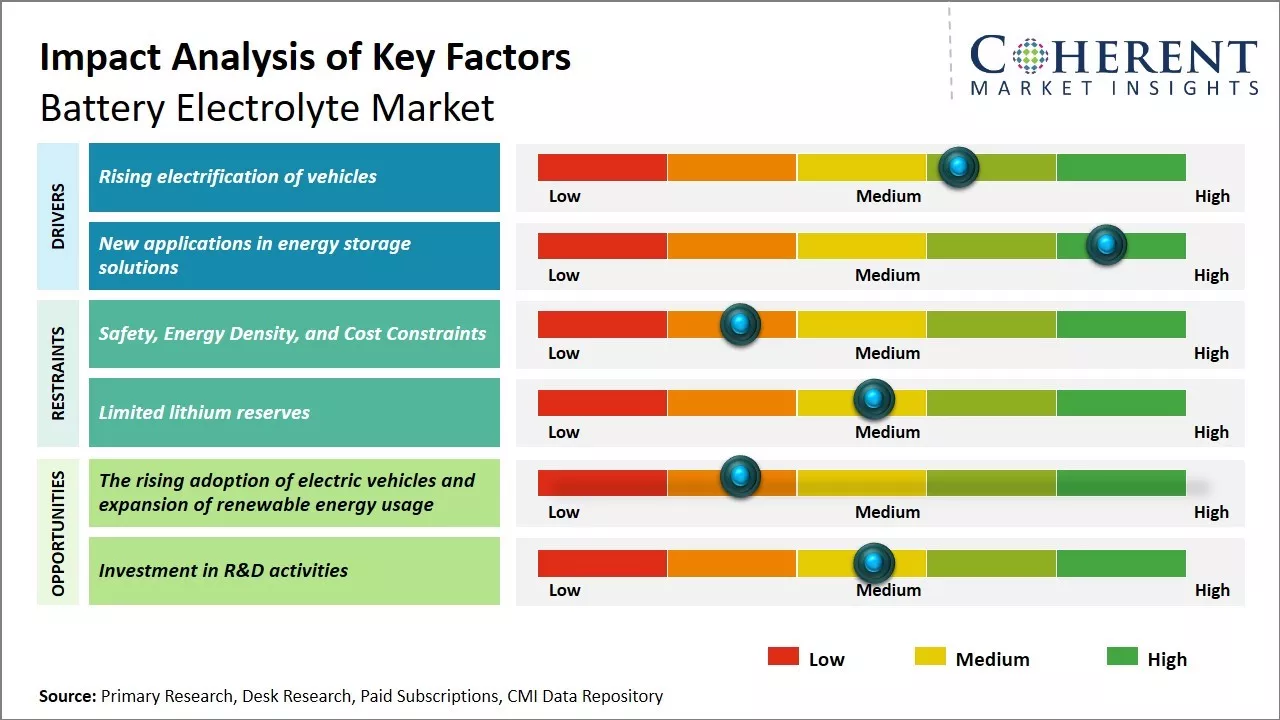
Discover market dynamics shaping the industry: Download Free Sample
The demand for battery electrolytes is anticipated to grow significantly over the next few years. With rising environmental concerns and stringent emission norms, adoption of electric vehicles is increasing rapidly across the world. Furthermore, increasing usage of consumer electronics and need for longer battery life is boosts sales of advanced lithium-ion batteries using innovative electrolytes. New product launches and capacity expansions by leading electrolyte manufacturers to cater to the growing EV battery market will further aid the market growth during the forecast period. Established players are also investing in R&D to develop high performance solid state batteries using advanced solid polymer electrolytes.
Rising electrification of vehicles
Global battery electrolyte market is greatly benefiting from rising electrification of vehicles across the globe. With growing environmental concerns and stringent emission norms, automakers are putting increased focus on electric vehicles. Many countries have also proposed bans on internal combustion engine vehicles to accelerate the transition to cleaner mobility solutions. This has boosted the demand for lithium-ion batteries from the automotive industry. As battery electrolytes form a key component of lithium-ion batteries, their usage is also growing substantially with increased battery production. Various advances are also being made in battery technologies to improve energy density and safety, and this boosts need for advanced electrolyte formulations. Established automakers as well as new entrants are launching multiple electric vehicle models and making huge investments in battery production facilities. This is expected to drive growth of battery electrolyte market. Rising popularity of electric buses and trucks is another favorable factor. With many cities and companies supporting electrification of public transportation and commercial fleets, it will augment market opportunities.
Market Concentration and Competitive Landscape
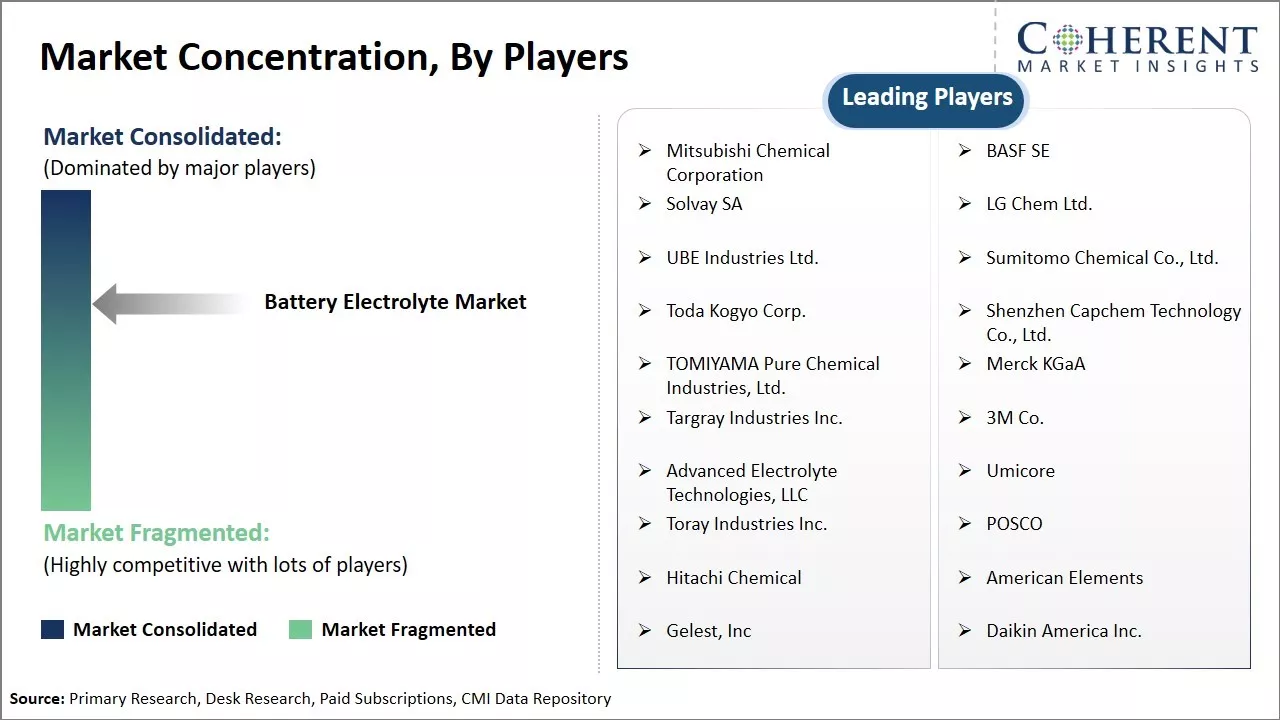
Get actionable strategies to beat competition: Download Free Sample
New applications in energy storage solutionsAnother important driver for the battery electrolyte market growth is increasing utilization of lithium-ion batteries in non-automobile applications such as consumer electronics, power tools, and stationary energy storage solutions. Lithium-ion batteries are becoming integral to daily lives through their usage in various portable electronic devices. The continuous expansion of applications is boosting demand for high-performance batteries. With rising integration of renewable energy sources, there is a growing emphasis on energy storage to effectively utilize generated power. Both residential and commercial properties are installing batteries to store solar power or to provide backup during power outages. Battery storage is also playing a critical role in managing electricity demand and supply at a larger utility-scale level. This widespread adoption of energy storage technologies will substantially augment the consumption of battery electrolytes in the coming years. Electrolyte manufacturers are developing novel formulations to meet the varying technical demands from diverse industries. Overall, new application sectors are emerging as important revenue generators for the battery electrolyte market.
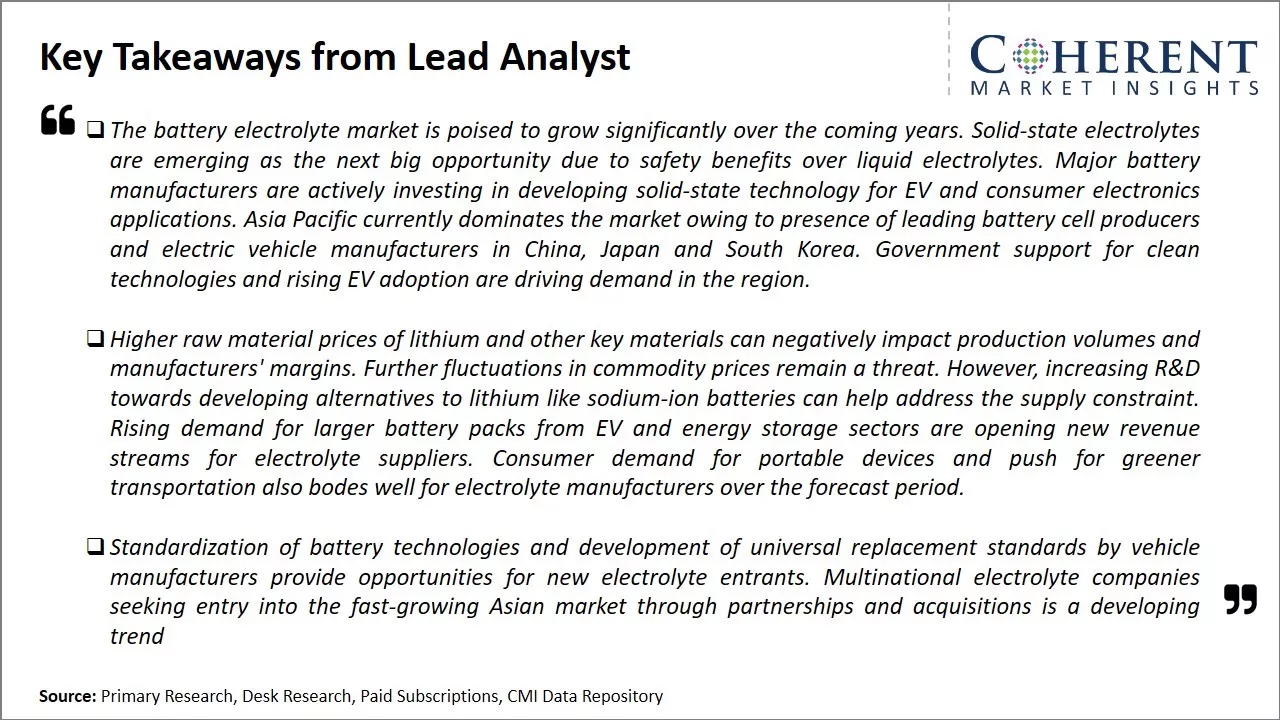
To learn more about this report, Download Free Sample
Market Challenges: Safety, Energy Density, and Cost ConstraintsGlobal battery electrolyte market faces several challenges. Battery technology is advancing rapidly to meet the growing demand for higher capacity batteries from various end-use industries like automotive and consumer electronics. Developing new electrolyte formulations that can support faster charging and higher energy densities within safety and cost constraints is challenging. Electrolyte leakage and flammability are key safety concerns that need to be addressed. Supply chain disruptions and rising raw material prices also pose challenges in maintaining cost competitiveness.
Market Opportunities: Rising adoption of electric vehicles and expansion of renewable energy usage
Rising adoption of electric vehicles and expansion of renewable energy usage is driving massive investments in large-scale battery storage globally. New electrolyte formulations that enable breakthrough battery technologies like solid-state batteries provide opportunities to capture new applications. Countries are offering subsidies and incentives for developing domestic advanced battery technologies presenting opportunities for electrolyte suppliers.
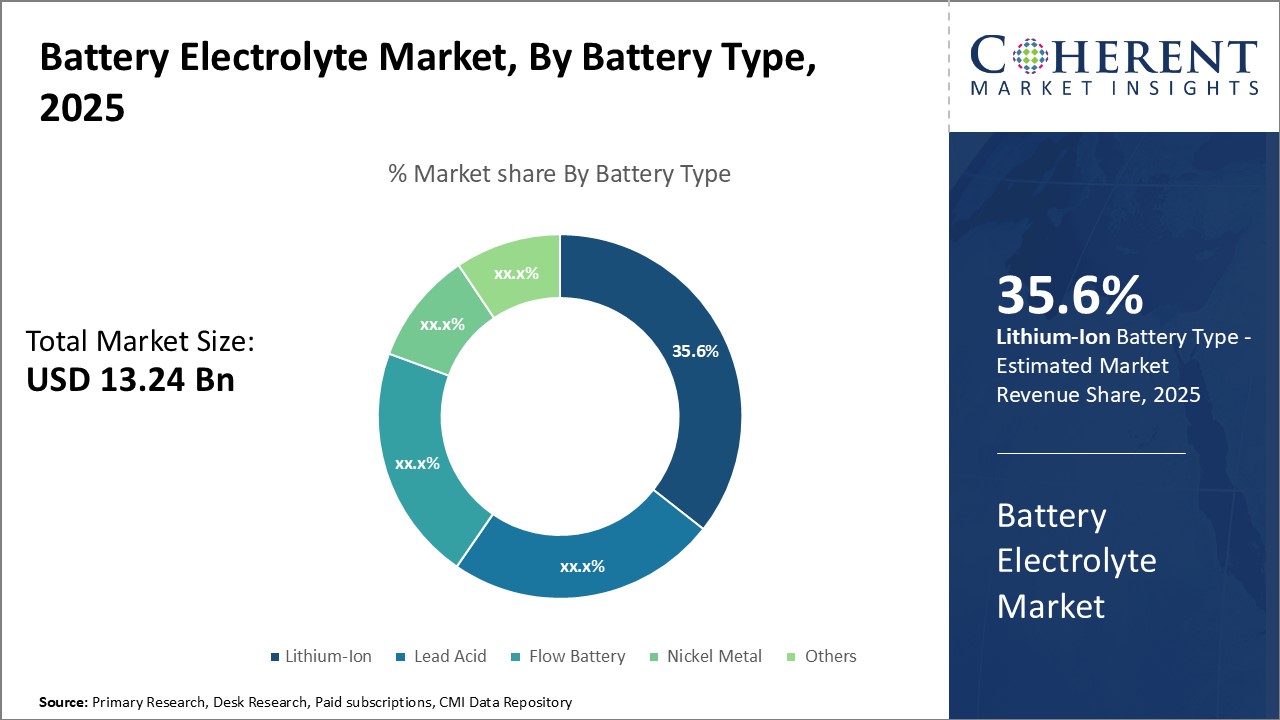
Discover high revenue pocket segments and roadmap to it: Download Free Sample
Insights, By Battery Type: Rising demand for portable devices drives lithium-ion segmentIn terms of battery type, lithium-ion segment is estimated to contribute the 35.6% share of the market in 2025, owing to its lightweight and high energy density characteristics. Lithium-ion batteries are widely used in portable consumer electronics such as smartphones, tablets, wearables and laptops due to their ability to provide long battery life in a compact form factor. As the use of portable connected devices continue to grow rapidly across both developed and developing countries, especially with higher deployment of 4G/5G networks, the demand for high-capacity lithium-ion batteries is also surging. The consumer preference for slimmer and multifunctional portable devices also encourages tech giants to focus more on improving battery life without compromising on form factor, further propelling the lithium-ion battery electrolyte market. Moreover, lithium-ion is regarded as the battery of choice for the burgeoning electric vehicle industry due to its high power-to-weight ratio and ability to undergo hundreds of charge-discharge cycles over the lifetime of an EV.
Insights, By Electrolyte Type: Liquid electrolyte dominates due to higher conductivity
In terms of electrolyte type, liquid electrolyte segment is estimated to contribute the 39.2% share of the market, owing to its higher ionic conductivity compared to other variants. Liquid electrolytes allow for higher diffusion rates of lithium ions between the anode and cathode during charging and discharging. This allows lithium-ion batteries to deliver fast charging capability and high power density, characteristics particularly important for applications with stringent power requirements such as consumer electronics and electric vehicles. Although gel and polymer electrolytes offer advantages like reduced leakage risk, their ionic conductivity is significantly lower than liquid electrolytes. As a result, liquid electrolyte remains the electrolyte of choice for the majority of lithium-ion batteries currently in the market.
Insights, By End User: Rapid EV proliferation catalyzes electric vehicle battery segment
In terms of end user, electric vehicle battery (EVs) segment is estimated to contribute the 41.6% share of the market due to strong policy push for electrification of transport globally. Stringent emission regulations coupled with falling battery prices have accelerated the pace of EV adoption in the last few years. Major automakers are aggressively ramping up EV production to meet escalating demand and regulatory requirements. According to estimates, global EV sales are projected to rise by over 40% annually till 2031. As EV batteries constitute nearly 30-40% of the total vehicle cost, intensive research is ongoing to develop high energy density low-cost battery technologies such as solid-state batteries. This will not only improve EV driving ranges but also accelerate the battery cost decline. As EV batteries have a limited lifespan of around 8-10 years, their replacements also contribute meaningfully to the battery electrolyte demand.
Regional Insights
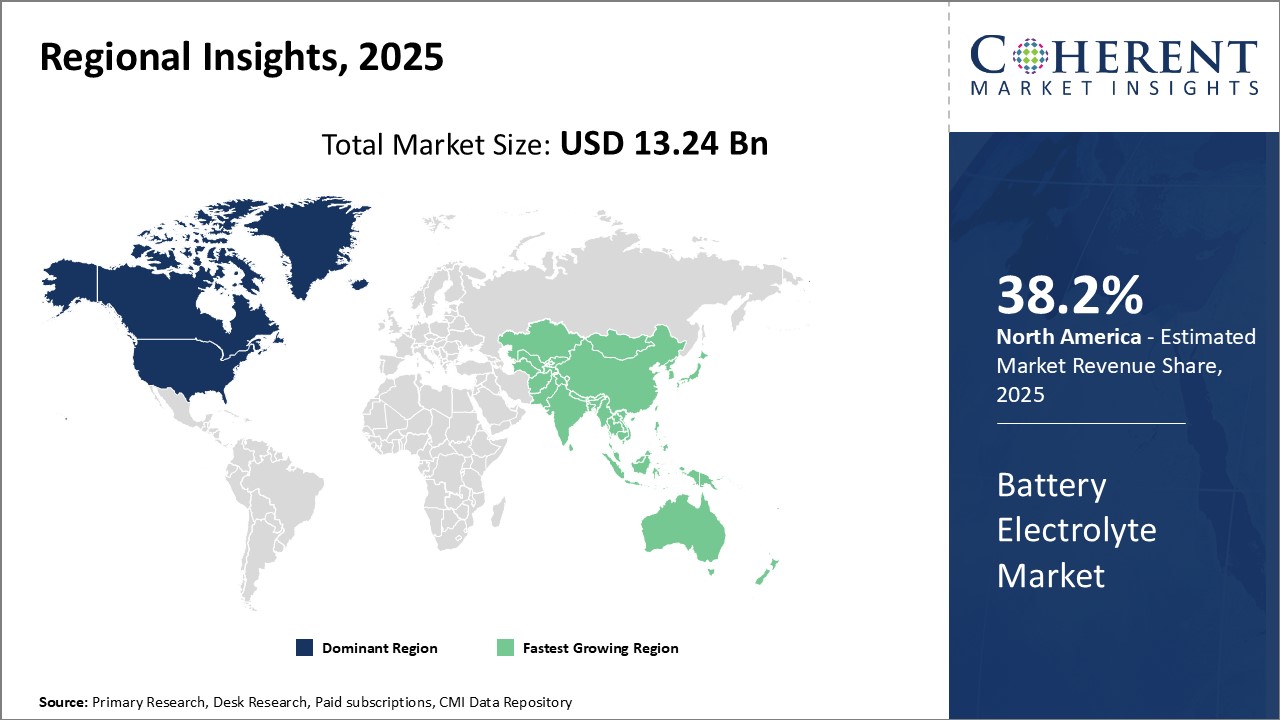
Need a Different Region or Segment? Download Free Sample
North America has established itself as the dominant region in the global battery electrolyte market over the years with estimated 38.2% share in 2025. The widespread presence of leading battery and battery material manufacturers such as Johnson Controls, Tesla, Panasonic, LG Chem has boosted electrolyte production capacity in the region. Further, rising adoption of electric vehicles favored by supportive governmental policies and investments in charging infrastructure has boosted demand for advanced lithium-ion batteries. The region also has a competitive edge due to low-cost feedstock availability and an established R&D ecosystem encouraging continuous innovations and development of newer electrolyte formulations.
The Asia Pacific region has emerged as the fastest growing market for battery electrolytes globally in recent times. China, being the leading battery and EV producer, accounts for the majority of the regional electrolyte production. The Chinese electrolyte industry is characterized by the presence of global scale producers with integrated operations. Moreover, regional free-trade agreements have amplified cross-border electrolyte trade between China, Japan, and South Korea who are key battery material exporting nations. This has augmented Asia Pacific's electrolyte supply chain network to efficiently serve the growing internal as well as external battery market demands. Countries like India is witnessing massive investments by international corporations to set up localized electrolyte units in light of rising opportunities in electric mobility and energy storage applications. The competitive pricing and proximity to large battery manufacturers provide tailwinds for Asia Pacific's leadership position in the future as well.
Market Report Scope
Battery Electrolyte Market Report Coverage
| Report Coverage | Details | ||
|---|---|---|---|
| Base Year: | 2024 | Market Size in 2025: | USD 13.24 Bn |
| Historical Data for: | 2020 To 2024 | Forecast Period: | 2025 To 2032 |
| Forecast Period 2025 to 2032 CAGR: | 12.3% | 2032 Value Projection: | USD 29.84 Bn |
| Geographies covered: |
|
||
| Segments covered: |
|
||
| Companies covered: |
Mitsubishi Chemical Corporation, BASF SE, Solvay SA, LG Chem Ltd., UBE Industries Ltd., Sumitomo Chemical Co., Ltd., Toda Kogyo Corp., Shenzhen Capchem Technology Co., Ltd., TOMIYAMA Pure Chemical Industries, Ltd., Merck KGaA, Targray Industries Inc., 3M Co. , Advanced Electrolyte Technologies, LLC, Umicore, Toray Industries Inc., POSCO, Hitachi Chemical, American Elements, Gelest, Inc, Daikin America Inc. |
||
| Growth Drivers: |
|
||
| Restraints & Challenges: |
|
||
Uncover macros and micros vetted on 75+ parameters: Get instant access to report
Battery Electrolyte Industry News
- In March 2024, Researchers at the University of Liverpool, U.K., developed a new solid-state battery electrolyte that conducts lithium ions
- In February 2022, US Vanadium announced an expanded purchase agreement under which Austria-based Enerox, which sells vanadium redox flow battery (VRFB) systems under its brand name CellCube, can purchase up to 3 million additional liters/year of US Vanadium's ultra-high-purity electrolyte with a price cap over the next five years
- In January 2022, Nexeon Limited, a supplier of advanced silicon anode materials for next-generation lithium-ion batteries, licensed its NSP-1 technology to advanced materials giant SKC Co. Ltd. The move ensures that customers globally have fast and reliable access to these strategic materials
- In April 2021, Hitachi, Ltd. developed an organic solid electrolyte, featuring both less volatility and chemical durability using materials informatics technology and has successfully fabricated a longlife LIB prototype using this electrolyte
*Definition: Battery electrolyte market includes electrolyte fluids used within all types of batteries. Electrolytes allow the transfer of ions between the anode and cathode, facilitating the electrochemical reactions that power devices. Common battery electrolytes include sulfuric acid, used in automotive lead-acid batteries; lithium salts dissolved in organic solvents, used in lithium-ion batteries found in consumer electronics; and alkaline solutions like potassium hydroxide, used in alkaline batteries.
Market Segmentation
- Battery Type Insights (Revenue, USD Bn & KT, 2020 - 2032)
- Lithium-Ion
- Lead Acid
- Flow Battery
- Nickel Metal
- Others
- Electrolyte Type Insights (Revenue, USD Bn & KT, 2020 - 2032)
- Liquid Electrolyte
- Solid Electrolyte
- Gel Electrolyte
- Others
- End User Insights (Revenue, USD Bn & KT, 2020 - 2032)
- Industrial
- Transportation
- Energy Storage
- Consumer Electronics
- Electric Vehicle Battery (EVs)
- Residential
- Others
- Regional Insights (Revenue, USD Bn & KT, 2020 - 2032)
- North America
- U.S.
- Canada
- Latin America
- Brazil
- Argentina
- Mexico
- Rest of Latin America
- Europe
- Germany
- U.K.
- Spain
- France
- Italy
- Russia
- Rest of Europe
- Asia Pacific
- China
- India
- Japan
- Australia
- South Korea
- ASEAN
- Rest of Asia Pacific
- Middle East & Africa
- GCC Countries
- Israel
- Rest of Middle East & Africa
- North America
- Key Players Insights
- Mitsubishi Chemical Corporation
- BASF SE
- Solvay SA
- LG Chem Ltd.
- UBE Industries Ltd.
- Sumitomo Chemical Co., Ltd.
- Toda Kogyo Corp.
- Shenzhen Capchem Technology Co., Ltd.
- TOMIYAMA Pure Chemical Industries, Ltd.
- Merck KGaA
- Targray Industries Inc.
- 3M Co.
- Advanced Electrolyte Technologies, LLC
Share
Share
About Author
Yash Doshi is a Senior Management Consultant. He has 12+ years of experience in conducting research and handling consulting projects across verticals in APAC, EMEA, and the Americas.
He brings strong acumen in helping chemical companies navigate complex challenges and identify growth opportunities. He has deep expertise across the chemicals value chain, including commodity, specialty and fine chemicals, plastics and polymers, and petrochemicals. Yash is a sought-after speaker at industry conferences and contributes to various publications on topics related commodity, specialty and fine chemicals, plastics and polymers, and petrochemicals.
Missing comfort of reading report in your local language? Find your preferred language :
Transform your Strategy with Exclusive Trending Reports :
Frequently Asked Questions
EXISTING CLIENTELE
Joining thousands of companies around the world committed to making the Excellent Business Solutions.
View All Our Clients
